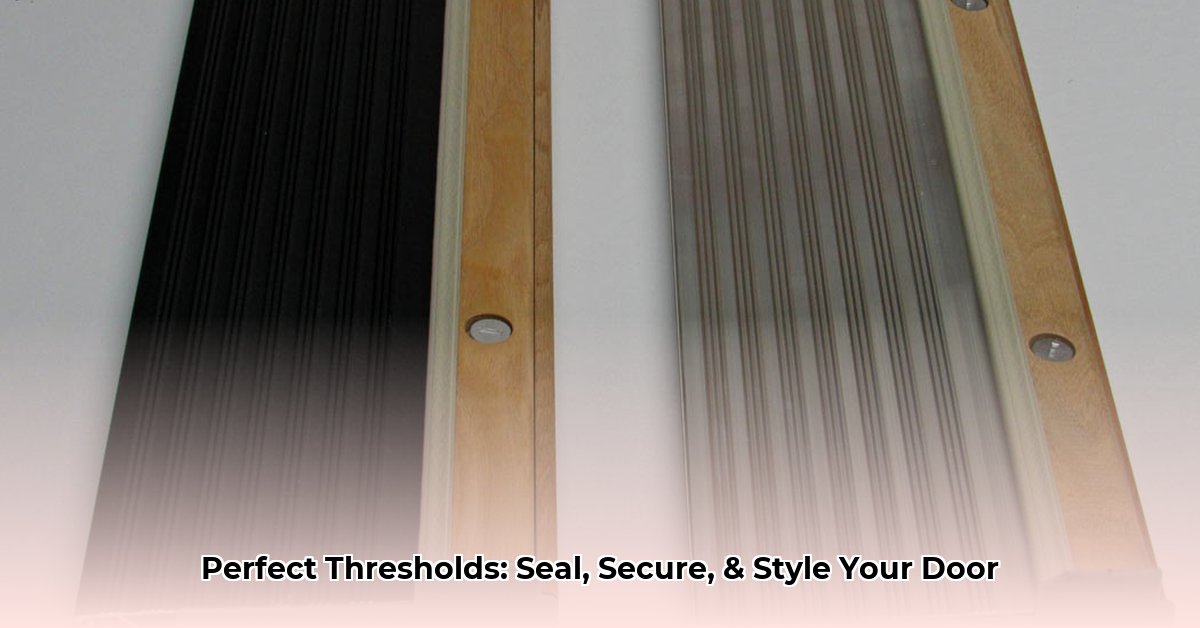Choosing the Right Threshold
Your door threshold is more than just a piece of the frame; it’s your first line of defense against the elements, pests, and energy loss. Choosing the right one involves considering your climate, door type, and budget. This guide breaks down everything you need to know to make the best decision for your home.
Material Matters
Picking the right threshold material is crucial. It’s like choosing the right shoes for the job – you need something durable, comfortable, and fit for purpose.
- Aluminum: Budget-friendly, rust-resistant, and durable, aluminum is a great choice for high-traffic areas. However, it conducts heat, so it might feel cold in winter. Some research suggests newer aluminum thresholds incorporate thermal breaks to mitigate this.
- Wood: A classic choice offering a warm, natural aesthetic and decent insulation. However, wood requires regular sealing and maintenance to prevent rot and decay.
- Vinyl: An economical and low-maintenance option, vinyl is suitable for milder climates. It can become brittle in extreme temperatures, though ongoing research explores more resilient vinyl formulations.
- Composite: Blending the best qualities of different materials, composites are durable, weather-resistant, and often insect-proof. They typically come at a higher price point, but their longevity may offset the initial cost.
- Fiberglass: Durable and offering better insulation than aluminum, fiberglass is a less common but viable alternative. It requires minimal maintenance and resists moisture damage.
Style Guide
Threshold styles are designed for specific needs and door types:
- Saddle: The most common type, with a gentle slope for easy transitions, ideal for single entry doors.
- Adjustable: Perfect for uneven floors or doors needing a tighter seal, offering flexibility for a customized fit.
- Interlocking: Designed specifically for double doors (like French doors), creating a weather-tight seal between them.
- Automatic Door Bottoms: The ultimate in weather protection and energy efficiency, automatically dropping down to seal when the door closes.
Matching Threshold to Door Type
Consider your door type when selecting a threshold:
- Single Entry Doors: Saddle or adjustable thresholds are generally suitable.
- Sliding Patio Doors: Specialized thresholds for sliding doors are necessary.
- French Doors: Interlocking thresholds are a common and effective choice.
- Garage Entry Doors: Choose durable materials like aluminum or composite to withstand the elements and potential impacts.
Climate Considerations
Your local climate plays a significant role:
- Extreme Temperatures: Avoid materials that become brittle or conduct heat easily.
- Rain and Snow: Prioritize thresholds with effective weatherstripping and drainage.
- Humidity: Opt for moisture-resistant materials to prevent rot and decay.
Installing Your Exterior Door Threshold: A Step-by-Step Guide
Installing a threshold is a manageable DIY project that can significantly improve your home’s comfort and protection.
Tools of the Trade
Gather your tools: measuring tape, safety glasses, saw (appropriate for your threshold material), drill, screws, caulk gun, and exterior-grade sealant.
Installation Steps
- Measure Twice, Cut Once: Precise measurements are essential. Measure the door opening width at least twice. Mark your cut lines carefully on the new threshold.
- Prep the Opening: Remove the old threshold and clean the area thoroughly. Repair any subfloor damage.
- Sill Pan Protection: Install a sill pan (flashing material) to direct water away from your home’s structure. Extend it slightly beyond the exterior wall.
- Secure the Threshold: Position the new threshold over the sill pan, pre-drill pilot holes (especially for wood or composite), and secure it firmly with screws.
- Seal the Deal: Apply exterior-grade sealant around all edges to create a watertight and airtight seal. Smooth the caulk with a wet fingertip.
Troubleshooting and Maintenance
Regular maintenance can extend the life of your threshold and prevent problems.
Preventative Care
- Regular Cleaning: Sweep or vacuum regularly to remove dirt and debris.
- Seasonal Inspections: Check for cracks, wear, and tear, and address issues promptly.
Troubleshooting Common Issues
| Problem | Likely Solutions |
|---|---|
| Drafts | Apply weatherstripping. Replace the threshold if the gap is significant. |
| Leaks | Reapply or replace caulk. Inspect and repair flashing around the door frame. |
| Sticking Door | Check and tighten or replace loose hinges. Plane or sand a swollen door. Rarely, the threshold may need adjustment. |
| Loose Threshold | Secure with new screws, wood filler, or construction adhesive. Anchors may be necessary. |
| Cracks | Repair minor cracks with epoxy or wood filler. Replace the threshold if damage is extensive. |
Material-Specific Maintenance
- Wood: Seal annually to protect against moisture.
- Aluminum/Composite/Vinyl: Clean regularly with a mild detergent.
Maintaining your exterior door threshold is a simple yet effective way to protect your home and improve its energy efficiency. While this guide covers common issues and solutions, remember that building codes and best practices can vary. Consulting local resources or professionals for specific advice is always recommended. Ongoing research may also yield new materials and techniques, so staying informed about the latest advancements can further enhance your home improvement efforts.
- Dora the Explorer Wipe-Off Fun: Safe & Mess-Free Activities for Little Explorers - April 18, 2025
- Does Lemongrass Repel Mosquitoes? Fact vs. Fiction + How to Use It - April 18, 2025
- Do Woodchucks Climb Trees?Fact vs. Fiction - April 18, 2025










